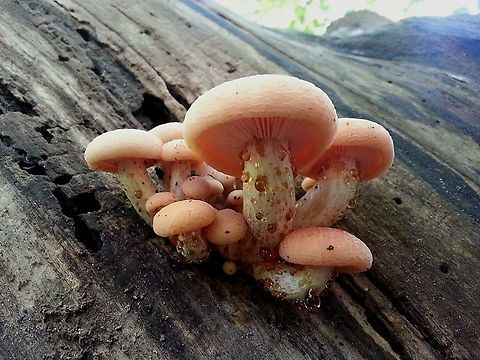
Appearance
CapInitially almost globose then convex with an inrolled margin and eventually almost flattening; pink when very young, becoming peach coloured. The tough cap skin (pellicle), which can be peeled completely, is thick and gelatinous and usually wrinkled in the form of a network of interconnected ridges. When fully developed caps range from 5 to 10cm across. The cap flesh is white.
Gills
The adnate to free gills are pinkish and moderately spaced.
Stem
Pinkish but paler than the cap, the stem of this mushroom is 3 to 7cm long and 1 to 1.5cm in diameter, without a stem ring, and is covered in whitish fibrils. 30–70 x 10–15mm, white to pinkish, covered in white fibrils; often bleeding red or orange droplets. The stem flesh is whitish tinged pink to orange. Because of its growing habit, stems of this mushroom are Invariably curved.
This is the only Rhodotus species; it is difficult to mistake it for any other mushroom.
Naming
he Wrinkled Peach was described in 1785 by French naturalist Jean Baptiste Francois (Pierre) Bulliard, who named it Agaricus palmatus.Distribution
Saprobic on well-rotted hardwood trunks and branches, usually of fallen elms but occasionally on other broadleaf timber.July to November in Britain and Europe. Rhodotus palmatus is also found in several countries of northern and central mainland Europe including the Scandinavian countries as well as Germany, Poland and Italy. This remarkable mushroom is also reported from parts of Asia and North America.Uses
The Wrinkled Peach Rhodotus palmatus is generally considered to be an inedible mushroom.References:
Some text fragments are auto parsed from Wikipedia.
https://www.first-nature.com/fungi/rhodotus-palmatus.php